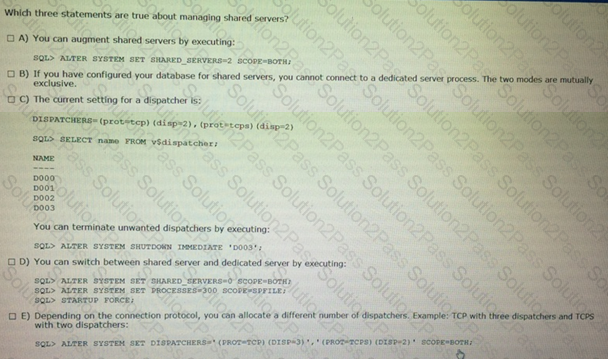1z0-497 Oracle Database 12c Essentials Free Practice Exam Questions (2025 Updated)
Prepare effectively for your Oracle 1z0-497 Oracle Database 12c Essentials certification with our extensive collection of free, high-quality practice questions. Each question is designed to mirror the actual exam format and objectives, complete with comprehensive answers and detailed explanations. Our materials are regularly updated for 2025, ensuring you have the most current resources to build confidence and succeed on your first attempt.
Which statement is true regarding this connect string?
(DESCRIPTION
(FAILOVER=on)
(ADDRESS_LIST=
(LOAD_BALANCE=ON)
(ADDRESS=(host=sales-east1) (port=1522) )
(ADDRESS=(host=sales-east2)(port=1522))
(ADDRESS=(host=sales-east3) (port=1522) ))
(ADDRESS_LIST=
(LOAD_BALANCE=ON)
(ADDRESS=(host=sales-west1) (port=1522) )
(ADDRESS=(host=sales-west2) (port=JS22))
(ADDRESS=(host=sales-west3) (port=lS22) ) )
(CONNECT_DATA=
(SERVICE_NAME=sales)
(REGION=east)))
The session of user SCOTT receives the following error after executing an UPDATE command on the EMP table:
ERROR at line 1:
ORA-00060: deadlock detected while waiting for resource
You find out that a session opened by user JIM has a transaction that caused the deadlock. Which two statements are true about SCOTT's session in this scenario?
Which normalization level is adopted in real-world database systems?
Which two items are key for maintaining data consistency in Oracle Database 12c?
Examine the command:
sqlplus /nolog
In which scenario would this command execute successfully?
After a ___________ statement is issued, a transaction ends. (select three)
In which situation would you use static database registration for a listener?
As part of your Oracle Database 12c post-installation tasks, you run these commands:
Cd $ORACLE_HOME/bin
srvctl stop database -d myDb
chopt enable dm
srvctl start database -d myDb
What does this do?
Which three statements represent the benefits of multitenant architecture for database consolidation?
Which two statements about multitenant architecture are true?
Identify the correct order of consolidation density.
Which two statements are true about a buffer cache?
You are about to install Oracle Database 12c Enterprise Edition. Which statement is true?
There are two listeners, LISTENER1 arid LISTENER2, and one service name ORCL available for your database. The database is running and currently, only LISIENER1 is started. You issue the command:
lsnrctl start listener2
What would be the outcome?
You are installing OracleDatabase 12c on a machine. When you run the installer; Oracle Universal installer (OUI) shows a message that says one of the product-specific prerequisite checks has failed:
Checking available swap space requirements...
Expected result: 1512MB
Actual Result: 1018MB
Check complete. The overall result of this check is: failed ««
Problem: The system does not have the required swap space.
What happens to the installation in this situation?
Your customer is looking for a solution that meets these four needs:
1 - Replicate data from source to target for reporting purposes.
2 -Replicate data from one source to multiple targets.
3 - Replicate data between two databases for instant failover.
4 - Replicate data from multiple sources to a single target for a data warehouse.
Which GoldenGate-supported topology would you recommended?
Your database is down. You log in as the SYS user and issue this command:
SQL> STARTUP
What happens after the instance is started?
Real-Time ADDM detects a high-load performance issue within the database. Which condition triggered it?
Which statement about a server parameter file (SPFILE) is false?

